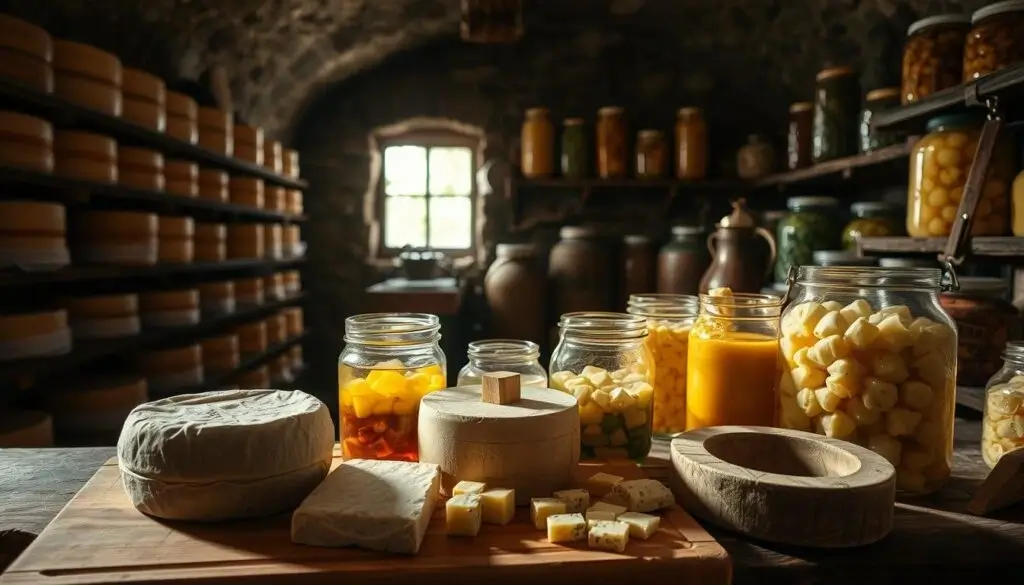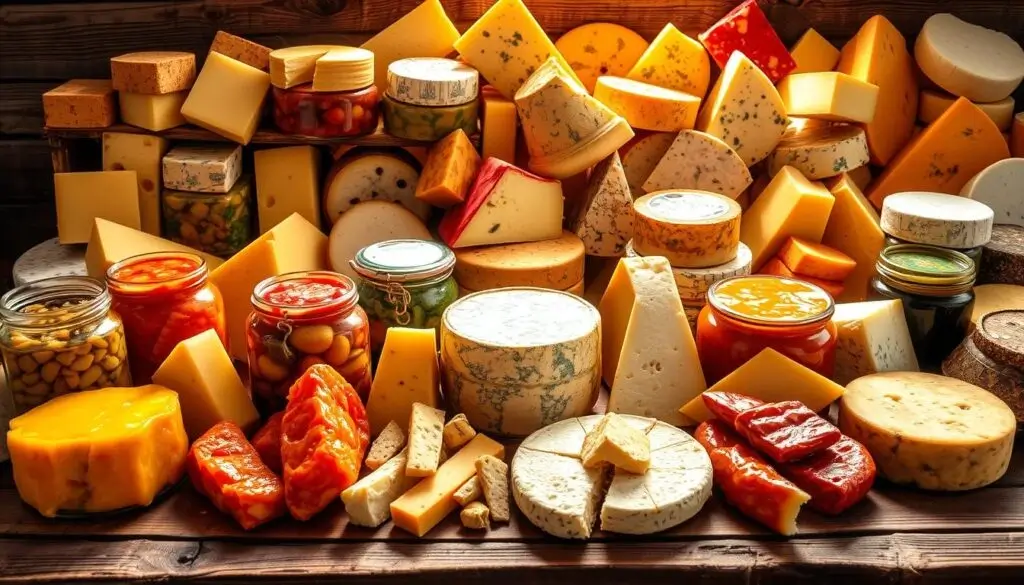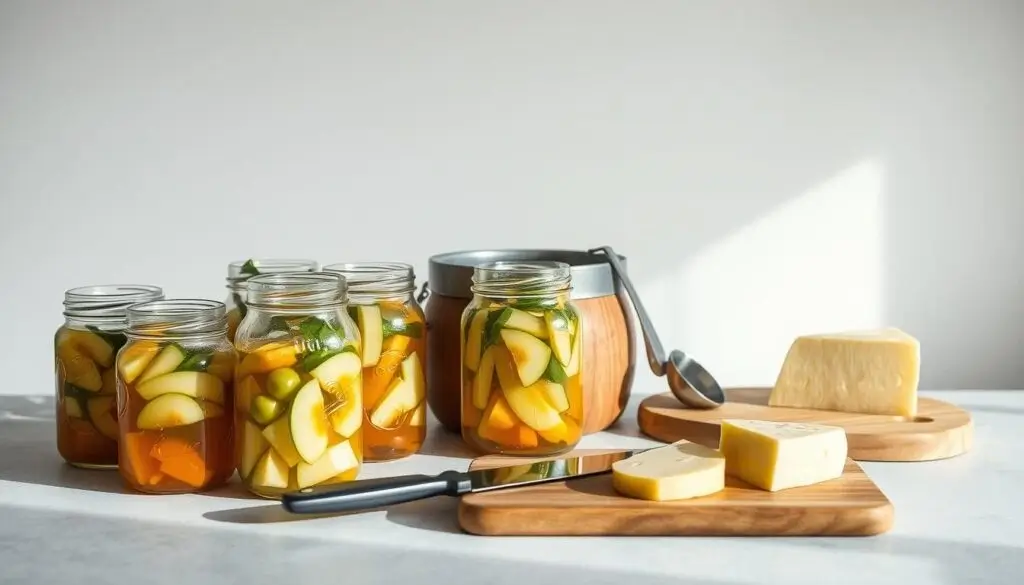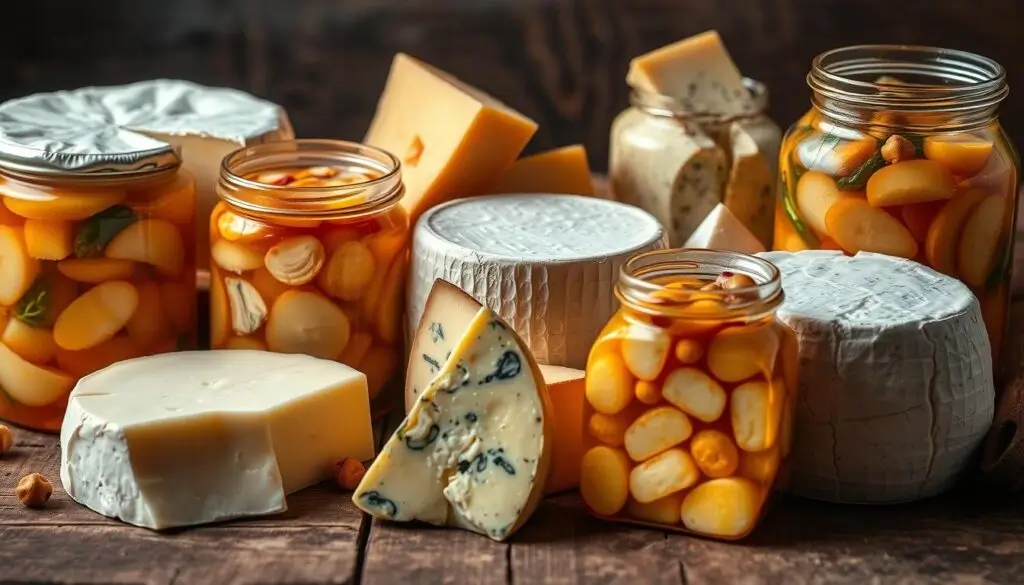The first time I tasted pickled cheese, it changed my cooking world. It started as a curious try of fermented dairy. But it turned into a deep love for a preservation method that has thrilled food fans for ages.
Pickled cheese is more than a tangy snack. It’s a joy in celebrating old cheese preservation ways. It mixes science, taste, and cultural history.
Cheese pickling is an old skill that turns regular dairy into amazing dishes. It brings out deep flavors and makes cheese last longer. Every bite shares a tale of cheesemakers through the ages who found the perfect mix of brine, spices, and fermentation.
Picture a world where cheese is a lively, evolving food. Traditional ways of keeping cheese alive make something truly special. This is what pickled cheese is all about, a tradition that connects cultures and adds depth to our meals.
Key Takeaways
- Pickled cheese is a traditional preservation method with rich cultural roots
- Fermented dairy offers unique flavor profiles and extended shelf life
- Cheese preservation techniques vary across different global cuisines
- Pickling transforms ordinary cheese into an extraordinary culinary experience
- The art of cheese pickling combines scientific precision with cultural tradition
Understanding Pickled Cheese: A Traditional Preservation Method

Cheese preservation has been key in cooking for thousands of years. Ancient people found clever ways to keep dairy products fresh. Pickling became a top way to keep cheese tasty and good for longer.
Pickling turns regular cheese into a special treat with better taste and longer life. This method uses techniques passed down through generations.
The Ancient Art of Cheese Preservation
Long ago, early farmers needed ways to keep food fresh. Cheese curing became a skill to keep dairy safe and tasty. It helped communities:
- Keep valuable dairy safe
- Make cheese taste more complex
- Store food longer
- Create unique cheese types
Chemical Process Behind Cheese Pickling
The pickling process uses special chemical reactions. Salt and acidic solutions stop bad bacteria and make cheese taste better.
| Pickling Component | Purpose | Effect on Cheese |
|---|---|---|
| Salt | Preservation | Stops bacteria growth |
| Vinegar | Acidification | Makes cheese tangy |
Benefits of Pickling Cheese
Pickling cheese has many benefits. It makes cheese last longer and adds new flavors. These can’t be found with just storing cheese.
- More nutrients
- Better taste
- Longer shelf life
- Good for gut health
Learning about these preservation methods shows the deep history of pickled cheese. It’s still loved today in cooking.
Popular Varieties of Pickled Cheese Around the World

Pickled cheese is a fascinating tradition found across cultures and continents. It shows how different cheeses are preserved in unique ways. This turns simple dairy into special cheese delicacies.
In the Mediterranean, cheese-making is a long-standing tradition. Greek Feta and Cypriot Halloumi are famous worldwide. They show the skill of preserving cheese through brining.
- Greek Feta: A crumbly sheep’s milk cheese preserved in saltwater brine
- Cypriot Halloumi: A firm cheese with remarkable grilling capabilities
- Bulgarian Sirene: A white brined cheese similar to Feta
- Middle Eastern Labneh: A tangy yogurt-based cheese preserved in olive oil
Every region has its own cheese-making traditions. Eastern Europe uses complex brining to improve taste and keep cheese fresh longer. Mexico and India also have their own ways of preserving cheese.
Today, cheesemakers are trying new things with old methods. They make new brined cheeses that mix old traditions with new tastes. These cheeses are exciting and stay true to their roots.
Essential Tools and Ingredients for Making Pickled Cheese at Home
Starting a cheese making journey needs careful planning and the right tools. Making artisanal cheese at home is fun and rewarding for those who love food. It lets them try traditional ways of preserving food.

For successful home cheese pickling, you need specific tools and knowledge. Cheese makers should get the right equipment and learn about pickling.
Required Equipment for Cheese Pickling
- Food-grade glass or ceramic containers
- Stainless steel pH meter
- Clean sterilization tools
- Precision kitchen scale
- Cheesecloth or fine mesh strainer
Selecting the Right Brine Components
Making the perfect brine is key for cheese curing. The salt level and flavorings greatly affect the cheese’s taste and how well it’s preserved.
| Brine Component | Purpose | Recommended Quantity |
|---|---|---|
| Kosher Salt | Primary preservation agent | 10-15% concentration |
| White Vinegar | Acidification | 5-7% of total volume |
| Herbs and Spices | Flavor enhancement | 1-2 tablespoons per quart |
Best Cheese Types for Pickling
Not all cheeses are good for pickling. Some types do better because of their special qualities.
- Feta cheese – High salt tolerance
- Goat cheese – Soft texture ideal for absorption
- Mozzarella – Mild flavor profile
- Halloumi – Firm texture maintains shape
Knowing these key points about cheese making and pickling helps home cooks make tasty pickled cheese. They can do it with confidence and creativity.
Serving and Pairing Suggestions for Pickled Cheese
Pickled cheese adds a tangy twist to any meal, turning it into a gourmet treat. It’s a favorite among those who love bold flavors. This specialty cheese is perfect for adding a unique taste to your dishes.
Creating the ideal pickled cheese platter is easy with these pairing tips:
- Charcuterie boards with artisanal cheeses
- Crisp salads with pickled cheese crumbles
- Rustic bread with pickled cheese spreads
Choosing the right drink can make pickled cheese even better. Pick beverages that match the cheese’s tangy taste:
| Cheese Type | Recommended Beverage |
|---|---|
| Soft Pickled-Cheese | Crisp Sauvignon Blanc |
| Hard Pickled-Cheese | Hoppy IPA Beer |
| Aged Pickled-Cheese | Dry Riesling |
How you present pickled cheese is important. Serve it on wooden boards, add fresh herbs, and include olives, nuts, and dried fruits. This makes your spread look amazing and will wow your guests.
Try serving pickled cheese chilled and at room temperature. This lets the flavors come alive, making every bite exciting.
Conclusion
An exciting journey through the world of food. It blends ancient cheese preservation techniques with new flavors, transforming ordinary cheese into something wonderful that people across the United States love.
It goes from old ways of keeping cheese to new cheese-making methods. Pickled cheese is a special way to enjoy dairy. Home cooks and chefs can try different brining methods. They find rich textures and complex flavors through careful cheese preservation.
More people are getting into fermented foods, making pickled cheese a big trend. If you love cheese or want to try new things, pickled cheese is a great start. It opens the door to the world of artisanal dairy.
As we learn more about fermented dairy, pickled cheese shows how creative and innovative food can be. By using these old techniques, we find new flavors in our favorite cheeses. Cottage Cheese Flatbread Recipes: Explore Delicious and Healthy Options
FAQ
What exactly is pickled cheese?
It is a type of cheese preserved in a flavored brine solution, which enhances its flavor and preserves it for a longer period. The cheese is soaked in a mixture of salt water, often with added herbs and spices, to give it a tangy flavor.
Which types of cheese are best for pickling?
The best cheeses for pickling are firm and semi-firm types. Feta, Halloumi, Queso Blanco, and Paneer are great choices. They keep their texture well when soaked in brine and soak up flavors nicely.
How long can pickled cheese be stored?
You can store pickled cheese in the fridge for 2-4 weeks. The salt and acid in the brine stop bacteria from growing. This lets the cheese last longer than fresh cheese.
What are the primary benefits of pickling cheese?
Pickling cheese has many benefits. It makes the cheese taste better, last longer, and can be good for your gut. It also keeps more of the cheese’s nutrients.
Can I make pickled cheese at home?
Yes, making pickled cheese at home is easy. You’ll need containers, cheese, salt, water, and spices. Make sure to sterilize everything and follow the brining steps carefully.
What equipment do I need for pickling cheese?
You’ll need sterilized glass jars, containers, a knife, pH strips, a thermometer, and clean tools. A pH meter is also good for checking the brine’s acidity.
Are there regional variations in pickled cheese?
Yes! Different places have their own pickled cheese traditions. Greek Feta, Turkish Lor Peyniri, Middle Eastern Shanklish, and Balkan Sirene are just a few examples. Each has its own way of preserving and flavoring cheese.
What are some common spices used in cheese pickling?
Common spices include peppercorns, bay leaves, garlic, dill, red pepper flakes, and oregano. These add unique flavors and enhance the cheese’s taste.
Is pickled cheese healthy?
It may be healthy, as it contains probiotics, protein, and calcium. However, it is high in sodium. It is best consumed in moderation. The fermentation process facilitates the digestion of nutrients.
How does pickling affect cheese texture?
Pickling makes cheese firmer and more compact. The brine’s salt and acid change the cheese’s texture. This makes the cheese denser and more flavorful.

